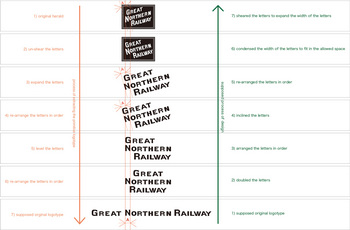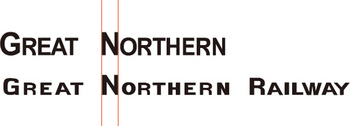Speed Lettering 17 – Reverse Engineering the Design [Column_Letters & Figures]
 : figure showing the supposed process of logotype design, GN as an instance
: figure showing the supposed process of logotype design, GN as an instanceMy question was that why C&NW and the followers introduced the italic font for their logotypes.
Relatively long names of the railroad made them difficult to apply their names on the side of boxcars.
For all these efforts aforementioned, the space of the side of a boxcar might be too small to achieve the goal.
The considered idea is to go typography: design the letter itself to achieve the goal. Now we can imagine one might have come to an idea of using italic font to apply large letters in a limited space.
Decreasing the width of regular letters seems the easiest way to apply letters in limited space. But, it seems that the readability would also decrease, considering the move of equipment. Italic font indeed has a more narrow width than regular font at its baseline. But, according to its inclined angle, the total width including dimension at the cap-line is almost the same as the regular letter (ex. dimension “A” illustrated above).
Accordingly, using italic font seems to be the way to keep readability regardless of its limited space.
Thus, it may be said that the pioneers’ purpose of introducing italic font was to save space: italic font’s primitive purpose, not to create the image of speed.
I tried reverse engineering the process of logotype-design using old GN logo-mark, the shortest among the pioneers, as an instance. The supposed process reflects the result of the inspection described before.
According to my reverse engineering, I extracted a logotype using the regular letter (bottom, the figure above) from the original logo-mark (top, the figure above). The width of the letter “N” is kept through the process (dimension “A” illustrated above).
Figure below shows the genuine logotype using regular font succeeding the square herald (top, figure below), and the extracted logotype (bottom, figure below). The reverse engineered logotype resembles the genuine logotype, isn’t it?
 : genuine logotype and extracted logotype
: genuine logotype and extracted logotyperevised, Mar. 5, 2021
なぜC&NWら斜体を用いるロゴタイプの先駆者たちは斜体を用いようと考えたのか。その理由について考察してきた。
名前を短縮したり改行したりといった工夫によって、文字を大きく表記した事例を見てきた。それから、先駆者たちは、これらの工夫によってもあまり文字を大きくできなかったことが推察された。
残るは、文字そのもののデザイン、すなわちタイポグラフィにより限られた幅の中に文字列をレイアウトする方法である。ひとつには正体(通常の字体)の幅を圧縮して狭める方法が考えられる。しかし、その場合、判読性が、特に走行する車両の側面に表記された場合、低下すると思われる。
そこで、斜体を用いる方法である。斜体のベースラインにおける字幅は確かに正体より狭い。しかし、その傾斜角ゆえ、キャップラインに至る全体で一文字の字幅を測った場合、それは正体とあまり変わらない。したがって、斜体をロゴタイプに用いると、文字の大きさはあまり変えることなく、すなわち判読性を維持しつつ、字幅を狭めることができるといえる。つまり、先駆者たちがロゴタイプに斜体を用いた当初の理由は、スペースを節約するためであり、スピード感とは関係なかったといえる。この理由は斜体の始原における制作理由と同じである。
さて、リバースエンジニアリング(Reverse engineering、直訳すれば逆行工学という意味)という、製造方法や動作原理を、分解したり動作を解析するなどしてものの構造を分析し、そこから製造方法や動作原理などを推測する方法がある。この方法をロゴタイプに適用してみた。
GNのロゴマークを事例に、時間を遡ってロゴタイプの形成過程を推察した過程を示す図が上の図である。図中一番下が、ロゴマークから逆に導き出した仮想のロゴタイプである。すなわち、ロゴマークの斜体を起こし正体に戻した上でNの文字の字幅(図中A)を基準に字幅を広げ合わせたものである。
この仮想のロゴタイプと、実際に用いられたロゴタイプは結構似ていると思うのだが(下の図)…。
2012-07-13 09:39
コメント(0)




コメント 0